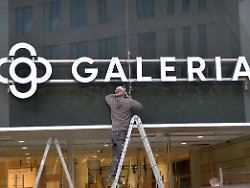Tuesday, October 26, 2021
Group carries out image change
Galeria opens completely renovated branches
Germany’s last large department store chain has already said goodbye to its old name. As a Galeria, she wants to offer her customers a completely new shopping experience in the future. Three pilot branches should give a foretaste of it from Wednesday.
Bye Karstadt! Goodbye Kaufhof! The traditional company Galeria Karstadt Kaufhof is reinventing itself. The retail giant, which still shapes many inner cities with its 131 department stores, wants to get back on its feet after difficult years under the name Galeria. “We want to become the networked heart of the city center,” said Galeria boss Miguel Müllenbach. To this end, the group intends to thoroughly remodel the branches, some of which are quite dusty, in the coming years.
“With our expensive downtown locations, we cannot be the price leader, but we can offer a special shopping experience – with selected products and a high quality of stay,” said Müllenbach, describing his plans. The department stores should “become places of well-being where people like to spend their free time – shopping, but also use services or enjoy gastronomy and culture”.
Germany’s last large department store chain plans to spend a total of 600 million euros on the modernization. Of this, 400 million euros are to flow into the upgrading of the department stores. Up to 60 houses are to be completely rebuilt, the rest at least partially. The online shop, IT and logistics are also to be upgraded. After the difficult times during the lockdown, Müllenbach is more optimistic about the future. “The corona pandemic has ensured that people do their shopping again in one fell swoop. That gives the department store with its old motto ‘everything under one roof’ a tailwind.”
Three branches, three models
The retail giant has already converted three department stores into pilot branches, which will allow a glimpse into the future from Wednesday. Take Frankfurt, for example: The department store on Hauptwache is supposed to show how the chain can hold its own in metropolitan areas against the competition from online retailers and branded stores. An important catchphrase here is “more premium” – on offer, but also around it. A champagne bar, a sushi menu from TV chef Steffen Henssler and a bar on the roof terrace with a view of the Frankfurt skyline should ensure more fun shopping.
The shop in Kassel, on the other hand, is supposed to be a “regional magnet” model for shops in somewhat smaller cities. Here, the retail giant wants to enrich the range of goods with services in order to better hold its own against Amazon. In the future there will be a branch office of the city administration in the department store, where identity cards can be applied for or picked up. At a parcel station you should be able to receive parcels from DHL and other delivery services. And in the parking garage you should also be able to have your bike repaired.
The branch in Kleve on the Dutch border is to act as a “local forum” model for smaller Galeria stores all over Germany. According to Müllenbach, the main thing here is to respond more to local needs.
“The Galeria branches collect around 250 million visitors a year. We have to get these customers to do more of their shopping with us than before. Then we will also regain market share,” says Müllenbach, belligerent. “Market analyzes have shown that our range has to become more trendy and of higher quality. We are now implementing that.”
Fight against Amazon and Co.
Galeria also wants to score more on the Internet. “This year we will generate sales of over 200 million euros online and we want to quadruple that soon,” explained Müllenbach. For the department store group, its future concept Galeria 2.0 is perhaps the last chance to assert itself in the fight against Amazon, H&M and the manufacturers’ branded stores.
Other retail chains are also in the process of adapting their branch network to the shopping habits that have changed due to the online boom. However, the answers to the challenges are different. The electronics chains Media Markt and Saturn, for example, want to focus more on smaller markets in the city centers. “For a long time, the motto was: More space and more products lead to more customers and sales. It’s not that easy today,” said Mediamarktsaturn boss Karsten Wildberger in the summer. The furniture chain Ikea, previously known primarily for its huge blue markets on the outskirts, now believes “firmly in the potential of smaller formats in central locations” and is experimenting with so-called pop-up stores and planning offices in city centers.
The perfumery chain Douglas, on the other hand, is currently designing new shops one size bigger. In addition to fragrances and creams, the flagship branches also offer manicures, skin care and other beauty treatments, including “botox to go”. The reason for this is likely to be the same that prompts Galeria to offer more services and events. The online competition simply cannot keep up with such offers.
